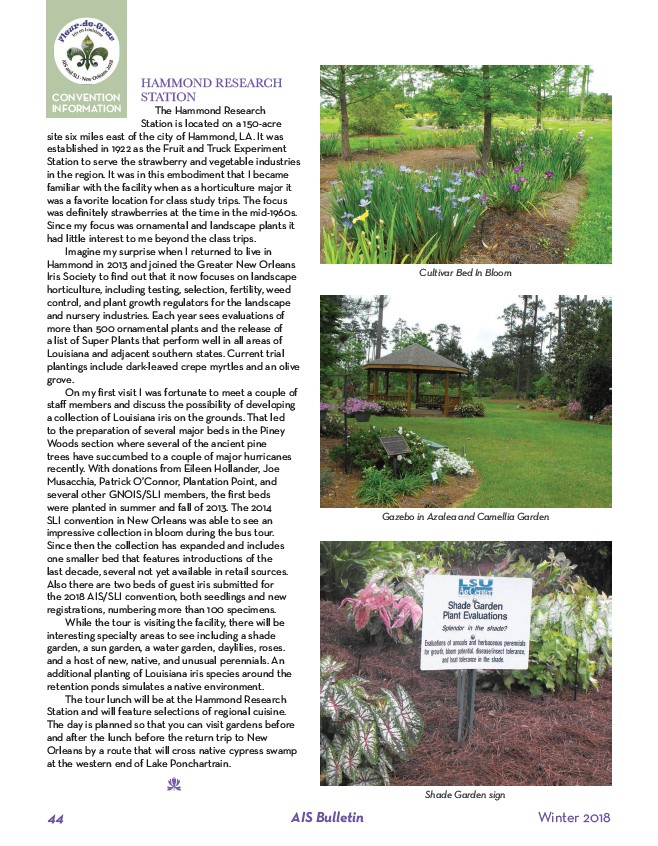
CONVENTION
INFORMATION
HAMMOND RESEARCH
STATION
The Hammond Research
Station is located on a 150-acre
site six miles east of the city of Hammond, LA. It was
established in 1922 as the Fruit and Truck Experiment
Station to serve the strawberry and vegetable industries
in the region. It was in this embodiment that I became
familiar with the facility when as a horticulture major it
was a favorite location for class study trips. The focus
was definitely strawberries at the time in the mid-1960s.
Since my focus was ornamental and landscape plants it
had little interest to me beyond the class trips.
Imagine my surprise when I returned to live in
Hammond in 2013 and joined the Greater New Orleans
Iris Society to find out that it now focuses on landscape
horticulture, including testing, selection, fertility, weed
control, and plant growth regulators for the landscape
and nursery industries. Each year sees evaluations of
more than 500 ornamental plants and the release of
a list of Super Plants that perform well in all areas of
Louisiana and adjacent southern states. Current trial
plantings include dark-leaved crepe myrtles and an olive
grove.
On my first visit I was fortunate to meet a couple of
staff members and discuss the possibility of developing
a collection of Louisiana iris on the grounds. That led
to the preparation of several major beds in the Piney
Woods section where several of the ancient pine
trees have succumbed to a couple of major hurricanes
recently. With donations from Eileen Hollander, Joe
Musacchia, Patrick O’Connor, Plantation Point, and
several other GNOIS/SLI members, the first beds
were planted in summer and fall of 2013. The 2014
SLI convention in New Orleans was able to see an
impressive collection in bloom during the bus tour.
Since then the collection has expanded and includes
one smaller bed that features introductions of the
last decade, several not yet available in retail sources.
Also there are two beds of guest iris submitted for
the 2018 AIS/SLI convention, both seedlings and new
registrations, numbering more than 100 specimens.
While the tour is visiting the facility, there will be
interesting specialty areas to see including a shade
garden, a sun garden, a water garden, daylilies, roses.
and a host of new, native, and unusual perennials. An
additional planting of Louisiana iris species around the
retention ponds simulates a native environment.
The tour lunch will be at the Hammond Research
Station and will feature selections of regional cuisine.
The day is planned so that you can visit gardens before
and after the lunch before the return trip to New
Orleans by a route that will cross native cypress swamp
at the western end of Lake Ponchartrain.
d
Cultivar Bed In Bloom
Gazebo in Azalea and Camellia Garden
Shade Garden sign
44 AIS Bulletin Winter 2018